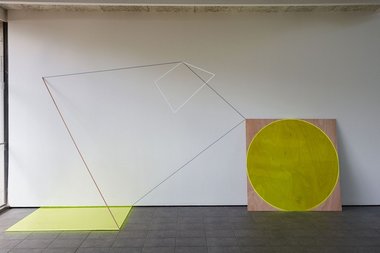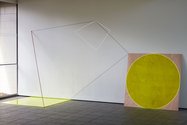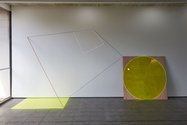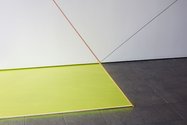John Hurrell – 28 April, 2018
Taylor's installation of quadrilateral diamonds and lemon square or circle shapes is articulated via leaning Perspex forms with glowing edges, pieces of dowelling and moving projected lines. It functions not as a diagram that has references beyond itself, but as an interactive anamorphic drawing. It exploits the explorative voluntary movements of the gallery visitor—and a resolution point for the moving eye—so that the seer and the seen are inseparable.
Pakuranga
Kāryn Taylor
Diagram for a Quantum Event
11 March - 30 April 2018
The notion of art being a diagram, an illustration of a theory, hypothesis or narrative is a ‘red rag’ to some critics and artists who like to dwell on the experiential. Their view is that quality art is not subservient to a theorem, philosophical principle or plot line by way of being a visual notation or chart; but that a visual statement should be intrinsically interesting in itself. This view embraces formalism—and I’m sympathetic. Like a hungry donkey I like a visual carrot to gnaw on: something to lead me into the work.
This installation by Kāryn Taylor alludes to the notion that any observer of subatomic activity (in particle physics) influences that activity simply by being present. They cannot document it as a neutrally occurring phenomenon; so all measurements are tainted. It pertains to the observer effect—linked to Niels Bohr—and not to be confused with the uncertainty principle that is linked to Werner Heisenberg. (BTW: readers interested in this area might enjoy Stephanie Bailey’s discussion of Asger Jorn and three team football in Di’van 3—see this link pp 101-113)
Taylor‘s installation of quadrilateral diamonds and lemon square or circle shapes is articulated via leaning Perspex forms with glowing edges, pieces of dowelling and moving projected lines (a la Anthony McCall). It functions not as a diagram that has references beyond itself, but as an interactive anamorphic drawing (in the self-portrait/skull tradition of Mike Parr, James Ross and Hans Holbein; or the brilliant peep boxes of Samuel van Hoogstraten). It exploits the explorative voluntary movements of the gallery visitor—and a resolution point for the moving eye—so that the seer and the seen are inseparable.
Using wall and floor planes on which rest differently angled linear forms (both moving and static; solidly planar and empty), the installation exploits the elegant appeal of geometric abstraction, much as painters like Robert Mangold, James Ross or Milan Mrkusich might do. And the textures of plywood overlaid with translucent materials as Simon Morris is currently doing at Two Rooms. The movement of the projected small quadrilateral is a clever foil for the viewer’s own activity as they check out the work’s own spatial layout—and watch the changing angles of the wooden rods and Perspex edges, noting also the work’s relationship to the floor tiles and ceiling.
The pleasures of body and mind in motion.
John Hurrell





 Two Rooms presents a program of residencies and projects
Two Rooms presents a program of residencies and projects Advertising in this column
Advertising in this column



This Discussion has 0 comments.
Comment
Participate
Register to Participate.
Sign in
Sign in to an existing account.